The global chlor-alkali market is estimated to be valued at USD 74.65 Bn in 2025 and is expected to reach USD 100.98 Bn by 2032, growing at a compound annual growth rate (CAGR) of 4.4% from 2025 to 2032.
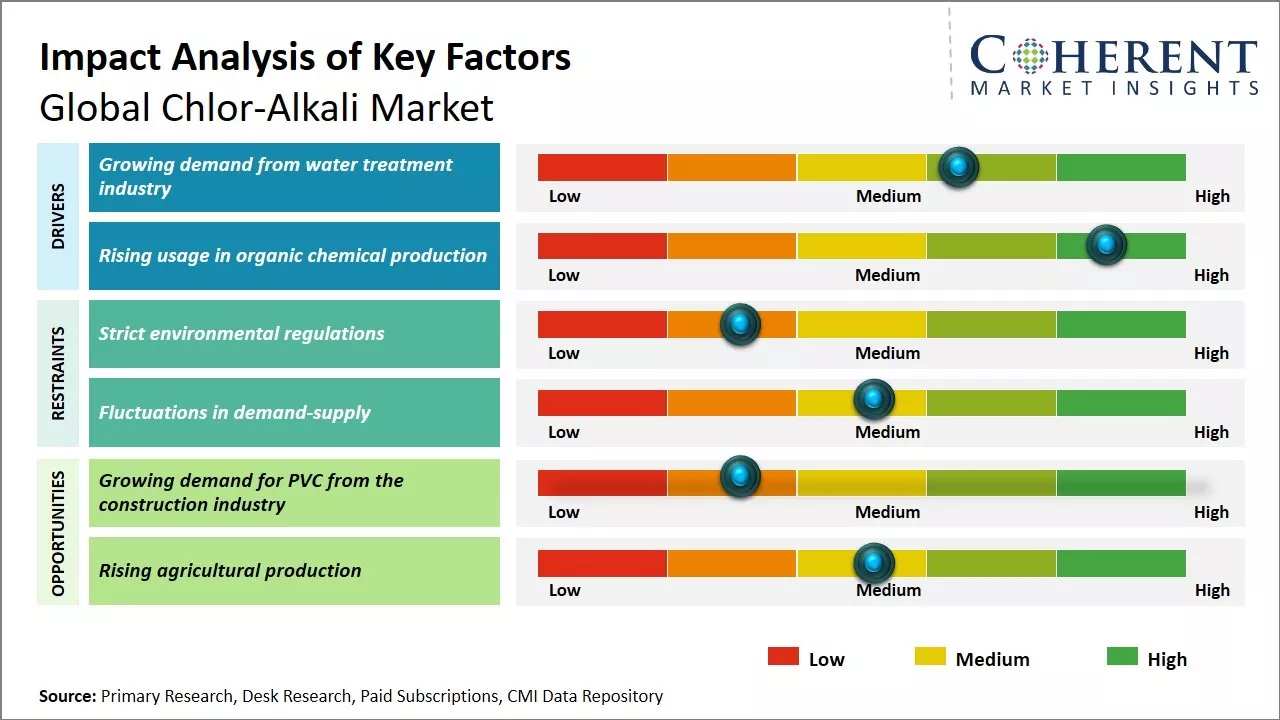
Discover market dynamics shaping the industry: Request sample copy
The global chlor-alkali market is expected witness steady demand driven by growth in end-use industries such as chemical processing, water treatment, pharmaceutical, paper & pulp and others. Within the chemicals industry, chlor-alkali is a critical building block material that serves as a key raw material for the production of numerous essential chemicals including polyvinyl chloride (PVC), ethylene dichloride (EDC), caustic soda, alumina, and titanium dioxide among others. Rapid industrialization and infrastructural development activities across emerging economies are expected to drive the demand for such derivatives, supplementing revenue generation in the global chlor-alkali market over the coming years.
Growing demand from water treatment industry
The water treatment industry is witnessing rising demand with growing global population and urbanization. Access to clean drinking water has become increasingly important for public health. The chlor-alkali market is benefiting from this demand as its products like chlorine and sodium hydroxide are extensively used in water treatment systems. Chlorine is used as a disinfectant to kill bacteria and other microorganisms in water. It acts as a potent sterilizing agent and helps ensure water reaching homes and industrial facilities is purified and safe for consumption. This application of chlorine in water treatment has been rising in both developed and developing nations across the world. For example, according to United Nations Children's Fund (UNICEF) data in 2020, over 800 million people around the world lack basic drinking water services and water disinfection needs augmentation. As more communities are to be provided access to safe water in coming years, the consumption of chlorine is projected to rise further. In addition to chlorine, the increasing complexity of water generated from various sources like surface water, seawater, and industrial wastewater has necessitated advanced treatment methods that employ caustic soda (sodium hydroxide) on a large scale. Sodium hydroxide is used for pH adjustment and removal of contaminants like heavy metals through processes like coagulation and precipitation. It plays a vital role in secondary and tertiary levels of water treatment. Considering the growing freshwater scarcity and water quality challenges facing many parts of the world due to climate change, industrialization and pollution as highlighted in UN Water reports, the usage of sodium hydroxide in water treatment applications is expected to see significant gains over the coming decade. This augurs well for the overall growth of the chlor-alkali industry.
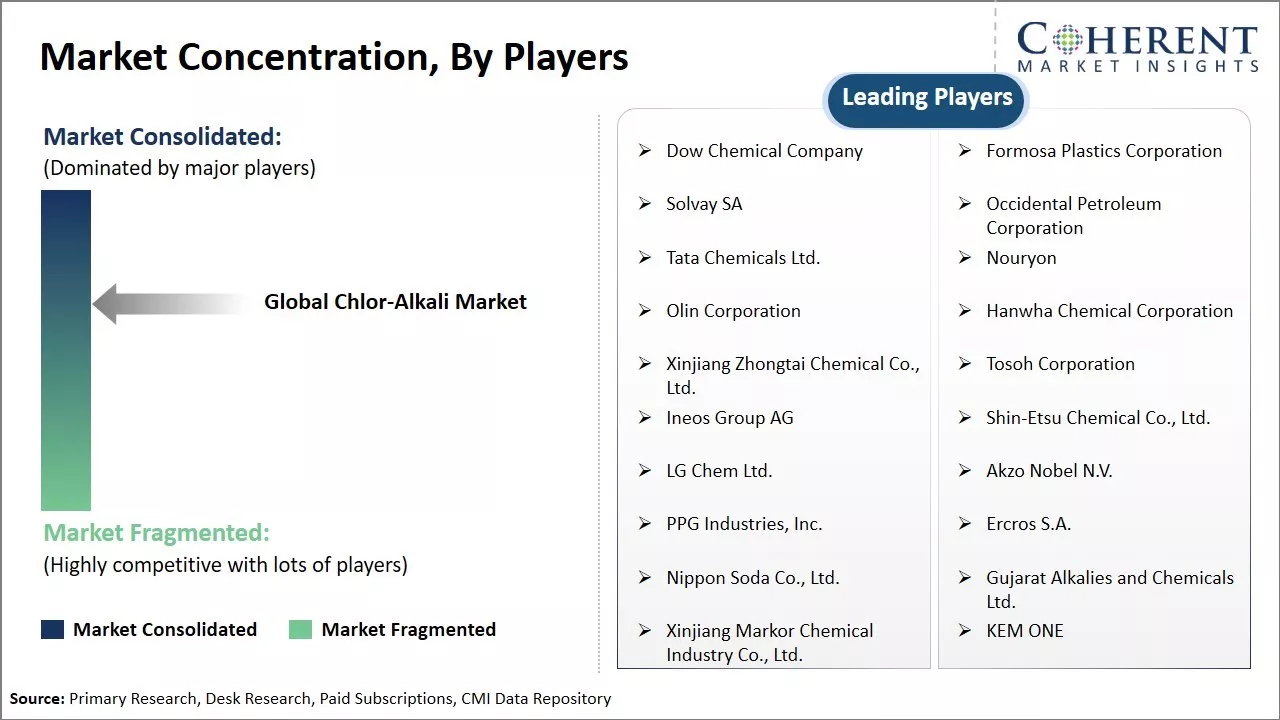
Get actionable strategies to beat competition: Request sample copy
Rising usage in organic chemical productionAnother major end-use segment where chlor-alkali chemicals find application is in the production of numerous organic chemicals. Chlorine is used as a raw material or intermediate in the manufacturing of several commodity chemicals like vinyl chloride monomer (VCM), ethylene dichloride (EDC), polyvinyl chloride (PVC) resins, ethylene, propylene oxide, and others. These chemical intermediates further serve as basic building blocks for myriad industrial and consumer products. In recent years, there has been substantial growth in global organic chemical production due to expanding end-use markets like consumer durables, automotive, packaging, construction, and agrochemicals. Developing regions across Asia Pacific and Latin America have also witnessed big surge in manufacturing activities which has boosted the domestic demand for organic chemicals. Chemical companies are making large investments in organic chemical facilities to serve both domestic and international clients. This rising production of organic chemicals worldwide will keep the demand for chlorine and chlor-alkali products vigorous in the long run.
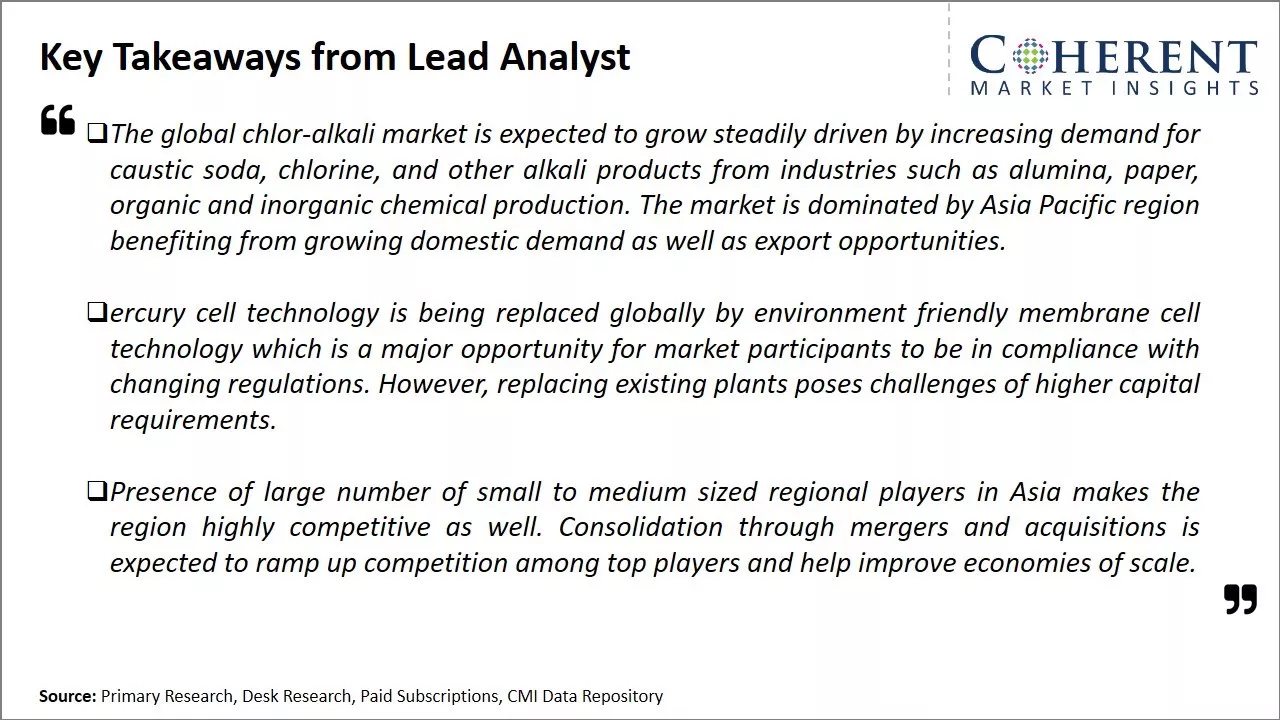
To learn more about this report, Request sample copy
Challenges: Strict environmental regulationsStrict environmental regulations around the production of caustic soda and chlorine have increased compliance costs for manufacturers. Additionally, overcapacity issues have led to declining profit margins. Substitute products also pose a threat as industries seek out greener alternatives. Recovery in key end-use industries such as alumina has been slower than expected as well.
Opportunities: Growing demand for PVC from the construction industry
The growing demand for PVC from the construction industry presents a major opportunity for growth in the global chlor-alkali market. PVC, or polyvinyl chloride, has emerged as one of the most widely used plastics in the modern construction sector due to its versatile properties and competitive pricing. It can be easily molded into various components like pipes, window frames, siding, flooring, and insulation boards. Some statistics reflect the scale of ongoing construction activities around the world and the resulting rise in PVC consumption. According to data from the United Nations, worldwide investment in infrastructure is expected to reach USD 94 trillion by 2040 to develop roads, bridges, utilities, and other construction needs. This will be fueled by rapid urbanization as more people migrate to cities in search of better living standards and employment. Asia and Africa are anticipated to absorb around two-thirds of all infrastructure investment over the next two decades. China alone plans to invest over USD 12 trillion in new projects by 2030. As developing economies prioritize housing, transportation, and energy projects, the production of PVC materials will necessarily need to keep up with demand.
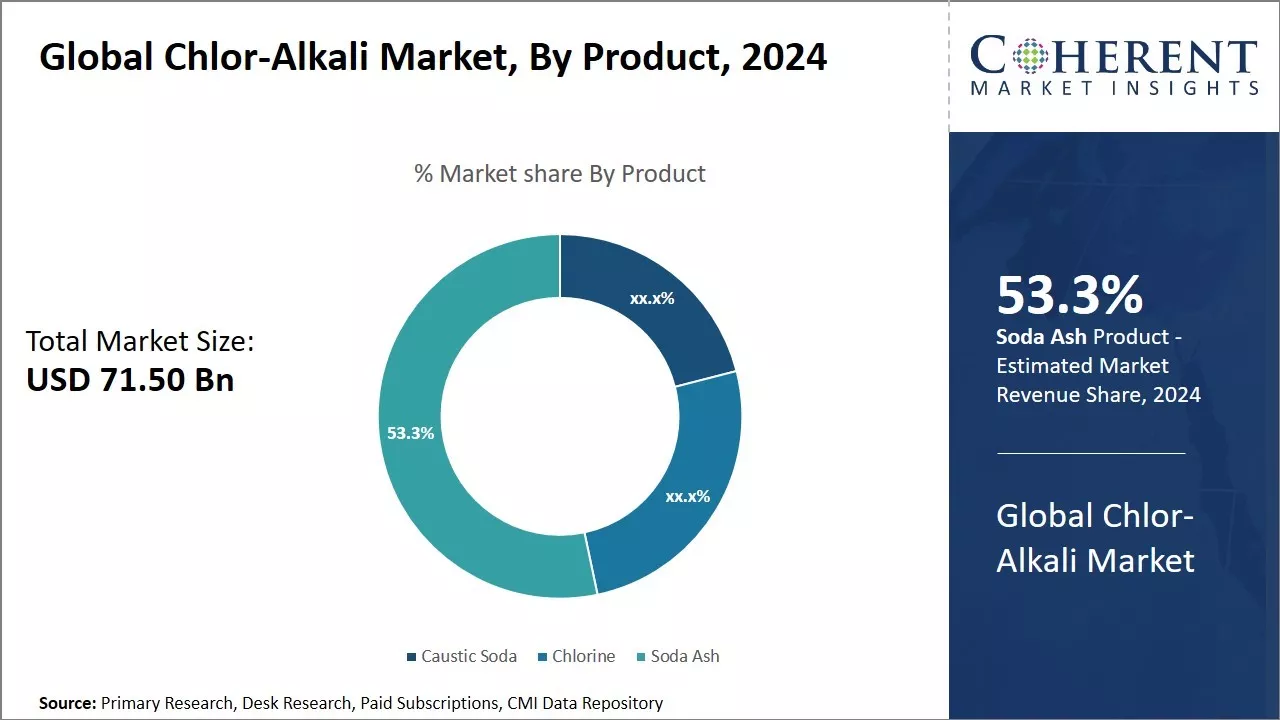
Discover high revenue pocket segments and roadmap to it: Request sample copy
Insights By Product: The Rise of the Pulp and Paper Industry Boosts the Soda Ash DemandIn terms of product, soda ash is expected to contribute 53.8% share of the market in 2025 owing to its increasing use in the flourishing pulp and paper industry. Soda ash, also known as sodium carbonate, acts as an important raw material in the manufacturing of paper. It has alkalinity properties that help remove lignin from wood fibers to extract cellulose needed for paper production. With more nations pushing initiatives to reduce reliance on plastics and increase paper product usage, pulp and paper companies are ramping up capacities. This bodes well for soda ash demand. Additionally, growing e-commerce is propelling corrugated packaging board demand, another major end-use for soda ash. Further, favorable government policies in developing nations supporting local paper industries also aids the soda ash market. Its cost-effectiveness relative to substitute products cements soda ash's dominant position.
Insights by Production Process: Rise of Membrane Cell Technology Drives Adoption
In terms of production process, membrane cell is expected to contribute 43.8% of the market share in 2025 owing to its technology advantages over traditional processes. Membrane cell technology provides higher energy efficiency and yields compared to diaphragm cell methods. It allows producers to reduce operating costs and lower carbon footprint. Additionally, membrane cells offer improved safety with reduced risk of gas leaks. Their modular design also enables easy capacity expansions. With sustainability and cost savings in sharp focus, many chlor-alkali companies are retrofitting plants or constructing new production facilities based on advanced membrane cell systems. Government incentives for green technologies further accelerate widespread adoption. R&D continues to enhance membrane cell performance, helping cement its position as the preferred production process.
Insights by Application: Pulp and Paper's Growing Needs Bolster its Leading Position
In terms of application, pulp and paper is expected to contribute 37.2% share of the market in 2025 owing to its massive requirement for chlor-alkali products. The paper manufacturing industry utilizes a variety of chemicals from the chlor-alkali sector. Chlorine is important for bleaching pulp to produce high-quality paper. Caustic soda acts as a pH regulator and processing agent. Soda ash provides alkalinity as mentioned earlier. With paper consumption on the rise globally, especially in developing Asian markets, production volumes are growing sharply. This significantly drives demand for chlor-alkali compounds from pulp and paper players. The sector also benefits from industry-friendly policies, free trade agreements and investor-friendly reforms in major pulp producing nations. Sustainability initiatives to increase usage of recycled paper further augment the segment's leading position.
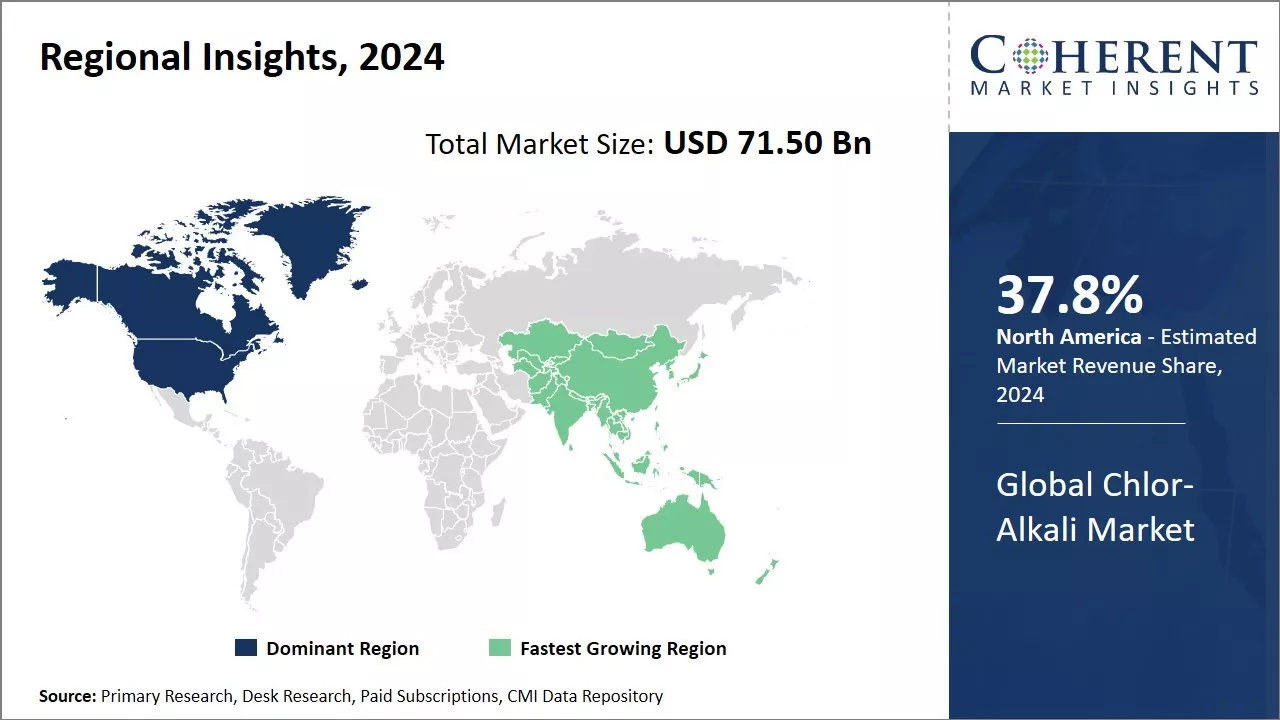
Need a Different Region or Segment? Customize now
North America has been the dominant region in the global chlor-alkali market for many decades. The region is expected to hold 38.3% of the market share in 2025. The region has a strong industrial base with presence of many key end-use industries such as chemicals, paper & pulp, pharmaceuticals, and water treatment. Large players in the chlor-alkali industry have their production facilities well-established in the U.S. and Canada in order to cater to the consistent demand from domestic end-users. Additionally, the region is an exporter of chlor-alkali products to the Latin American market. With access to raw materials and energy resources, producers in North America can ensure cost competitiveness over international counterparts. However, environmental regulations surrounding mercury cell technology adoption are increasing the operational costs for industry players in the region.
The Asia Pacific region has emerged as the fastest growing market for chlor-alkali globally. Propelled by the rapid industrialization and infrastructure development in emerging economies, the demand for chlor-alkali and its downstream products is augmented. As countries like China, India, Indonesia, and Vietnam see huge investments in end-use verticals, their requirements for chlorine, caustic soda, and potassium hydroxide are rising steadily. This has also encouraged chlor-alkali producers to set up new production units and expand existing facilities. While China dominates the current export demand for chlor-alkali in Asia Pacific, other ASEAN nations are seen as new hotspots in the coming years. The Asia Pacific nations also import substantial volumes from Persian Gulf producers to fulfill their expanding consumption needs. With a burgeoning middle-class population and improving economic outlook, the Asia Pacific chlor-alkali market is projected to witness sustained growth over the long run.
Chlor-Alkali Market Report Coverage
| Report Coverage | Details | ||
|---|---|---|---|
| Base Year: | 2024 | Market Size in 2025: | USD 74.65 Bn |
| Historical Data for: | 2020 To 2024 | Forecast Period: | 2025 To 2032 |
| Forecast Period 2025 to 2032 CAGR: | 4.4% | 2032 Value Projection: | USD 100.98 Bn |
| Geographies covered: |
|
||
| Segments covered: |
|
||
| Companies covered: |
Dow Chemical Company, Formosa Plastics Corporation, Solvay SA, Occidental Petroleum Corporation, Tata Chemicals Ltd., Nouryon, Olin Corporation, Hanwha Chemical Corporation, Xinjiang Zhongtai Chemical Co., Ltd., Tosoh Corporation, Ineos Group AG, Shin-Etsu Chemical Co., Ltd., LG Chem Ltd., Akzo Nobel N.V., PPG Industries, Inc., Ercros S.A., Nippon Soda Co., Ltd., Gujarat Alkalies and Chemicals Ltd., Xinjiang Markor Chemical Industry Co., Ltd., and KEM ONE |
||
| Growth Drivers: |
|
||
| Restraints & Challenges: |
|
||
Uncover macros and micros vetted on 75+ parameters: Get instant access to report
Definition: The global chlor-alkali market involves the manufacturing of chlorine and alkali products such as caustic soda (sodium hydroxide), soda ash (sodium carbonate), and potassium hydroxide. The key end-use industries for these products include alumina, chemical production, water treatment, pulp and paper, food processing, soaps and detergents, textiles, and metal fabrication.
Share
Share
About Author
Vidyesh Swar is a seasoned Consultant with a diverse background in market research and business consulting. With over 6 years of experience, Vidyesh has established a strong reputation for his proficiency in market estimations, supplier landscape analysis, and market share assessments for tailored research solution. Using his deep industry knowledge and analytical skills, he provides valuable insights and strategic recommendations, enabling clients to make informed decisions and navigate complex business landscapes.
Missing comfort of reading report in your local language? Find your preferred language :
Transform your Strategy with Exclusive Trending Reports :
Frequently Asked Questions
Joining thousands of companies around the world committed to making the Excellent Business Solutions.
View All Our Clients
US Reciprocal Tax Impact Analysis On Chlor-Alkali Market
Stay updated on tariff changes with expert insights and timely information